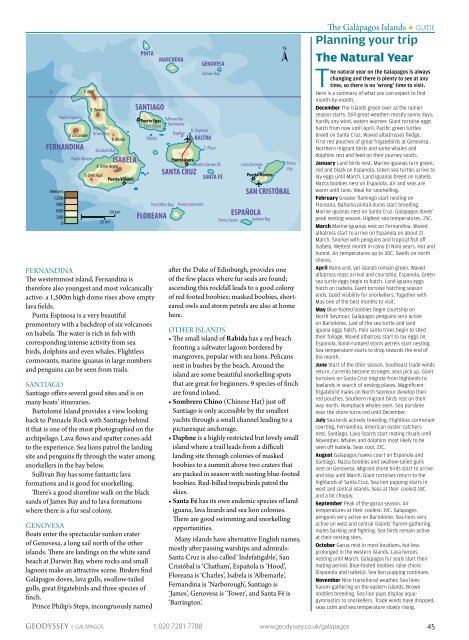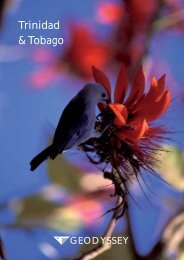Ecuador and the Galapagos Islands - Geodyssey
Ecuador and the Galapagos Islands - Geodyssey
Ecuador and the Galapagos Islands - Geodyssey
Create successful ePaper yourself
Turn your PDF publications into a flip-book with our unique Google optimized e-Paper software.
0 O<br />
FERNANDINA<br />
Metres<br />
1200<br />
900<br />
600<br />
300<br />
0<br />
V. Wolf<br />
SANTIAGO<br />
FLOREANA<br />
Fern<strong>and</strong>ina<br />
The westernmost isl<strong>and</strong>, Fern<strong>and</strong>ina is<br />
<strong>the</strong>refore also youngest <strong>and</strong> most volcanically<br />
active: a 1,500m high dome rises above empty<br />
lava fields.<br />
Punta Espinosa is a very beautiful<br />
promontory with a backdrop of six volcanoes<br />
on Isabela. The water is rich in fish with<br />
corresponding intense activity from sea<br />
birds, dolphins <strong>and</strong> even whales. Flightless<br />
cormorants, marine iguanas in large numbers<br />
<strong>and</strong> penguins can be seen from trails.<br />
Santiago<br />
Santiago offers several good sites <strong>and</strong> is on<br />
many boats’ itineraries.<br />
Bartolomé Isl<strong>and</strong> provides a view looking<br />
back to Pinnacle Rock with Santiago behind<br />
it that is one of <strong>the</strong> most photographed on <strong>the</strong><br />
archipelago. Lava flows <strong>and</strong> spatter cones add<br />
to <strong>the</strong> experience. Sea lions patrol <strong>the</strong> l<strong>and</strong>ing<br />
site <strong>and</strong> penguins fly through <strong>the</strong> water among<br />
snorkellers in <strong>the</strong> bay below.<br />
Sullivan Bay has some fantastic lava<br />
formations <strong>and</strong> is good for snorkelling.<br />
There’s a good shoreline walk on <strong>the</strong> black<br />
s<strong>and</strong>s of James Bay <strong>and</strong> to lava formations<br />
where <strong>the</strong>re is a fur seal colony.<br />
Genovesa<br />
Boats enter <strong>the</strong> spectacular sunken crater<br />
of Genovesa, a long sail north of <strong>the</strong> o<strong>the</strong>r<br />
isl<strong>and</strong>s. There are l<strong>and</strong>ings on <strong>the</strong> white s<strong>and</strong><br />
beach at Darwin Bay, where rocks <strong>and</strong> small<br />
lagoons make an attractive scene. Birders find<br />
Galápagos doves, lava gulls, swallow-tailed<br />
gulls, great frigatebirds <strong>and</strong> three species of<br />
finch.<br />
Prince Philip’s Steps, incongruously named<br />
GENOVESA<br />
Darwin Bay<br />
V. Darwin<br />
Punta Espinosa<br />
Puerto Egas<br />
Sullivan Bay<br />
Tagus Cove<br />
Som. Chino<br />
Bartolome<br />
N. Seymour<br />
V. La Cumbre Urvina Bay<br />
Daphne<br />
V. Alcedo<br />
Rábida<br />
BALTRA<br />
S. Plaza<br />
Elizabeth Bay<br />
Punta Moreno<br />
ISABELA<br />
Puerto Ayora<br />
V. Sierra Negra<br />
Charles Darwin RS<br />
León Dormido<br />
V. Cerro Azul<br />
SANTA CRUZ<br />
Puerto Moreno<br />
Puerto Villamil<br />
SANTA FÉ<br />
25 ml<br />
50 km<br />
PINTA<br />
MARCHENA<br />
Post Office Bay<br />
Punta Cormorant<br />
Punta Suarez<br />
<br />
SAN CRISTÓBAL<br />
ESPAÑOLA<br />
Gardner Bay<br />
<br />
Punta<br />
Pitt<br />
after <strong>the</strong> Duke of Edinburgh, provides one<br />
of <strong>the</strong> few places where fur seals are found;<br />
ascending this rockfall leads to a good colony<br />
of red footed boobies; masked boobies, shorteared<br />
owls <strong>and</strong> storm petrels are also at home<br />
here.<br />
O<strong>the</strong>r isl<strong>and</strong>s<br />
• The small isl<strong>and</strong> of Rabida has a red beach<br />
fronting a saltwater lagoon bordered by<br />
mangroves, popular with sea lions. Pelicans<br />
nest in bushes by <strong>the</strong> beach. Around <strong>the</strong><br />
isl<strong>and</strong> are some beautiful snorkelling spots<br />
that are great for beginners. 9 species of finch<br />
are found inl<strong>and</strong>.<br />
• Sombrero Chino (Chinese Hat) just off<br />
Santiago is only accessible by <strong>the</strong> smallest<br />
yachts through a small channel leading to a<br />
picturesque anchorage.<br />
• Daphne is a highly restricted but lovely small<br />
isl<strong>and</strong> where a trail leads from a difficult<br />
l<strong>and</strong>ing site through colonies of masked<br />
boobies to a summit above two craters that<br />
are packed in season with nesting blue-footed<br />
boobies. Red-billed tropicbirds patrol <strong>the</strong><br />
skies.<br />
• Santa Fé has its own endemic species of l<strong>and</strong><br />
iguana, lava lizards <strong>and</strong> sea lion colonies.<br />
There are good swimming <strong>and</strong> snorkelling<br />
opportunities.<br />
Many isl<strong>and</strong>s have alternative English names,<br />
mostly after passing warships <strong>and</strong> admirals:<br />
Santa Cruz is also called ‘Indefatigable’, San<br />
Cristóbal is ‘Chatham’, Española is ‘Hood’,<br />
Floreana is ‘Charles’, Isabela is ‘Albemarle’,<br />
Fern<strong>and</strong>ina is ‘Narborough’, Santiago is<br />
‘James’, Genovesa is ‘Tower’, <strong>and</strong> Santa Fé is<br />
‘Barrington’.<br />
The Galápagos Isl<strong>and</strong>s ê GUIDE<br />
Planning your trip<br />
The Natural Year<br />
The natural year on <strong>the</strong> <strong>Galapagos</strong> is always<br />
changing <strong>and</strong> <strong>the</strong>re is plenty to see at any<br />
time, so <strong>the</strong>re is no 'wrong' time to visit.<br />
Here is a summary of what you can expect to find<br />
month-by-month.<br />
December The isl<strong>and</strong>s green over as <strong>the</strong> rainier<br />
season starts. Still great wea<strong>the</strong>r: mostly sunny days,<br />
hardly any wind, waters warmer. Giant tortoise eggs<br />
hatch from now until April. Pacific green turtles<br />
breed on Santa Cruz. Waved albatrosses fledge.<br />
First red pouches of great frigatebirds at Genovesa.<br />
Nor<strong>the</strong>rn migrant birds <strong>and</strong> some whales <strong>and</strong><br />
dolphins rest <strong>and</strong> feed on <strong>the</strong>ir journey south.<br />
January L<strong>and</strong> birds nest. Marine iguanas turn green,<br />
red <strong>and</strong> black on Espanola. Green sea turtles arrive to<br />
lay eggs until March. L<strong>and</strong> iguanas breed on Isabela.<br />
Nazca boobies nest on Espanola. Air <strong>and</strong> seas are<br />
warm until June. Ideal for snorkelling.<br />
February Greater flamingo start nesting on<br />
Floreana. Bahama pintail ducks start breeding.<br />
Marine iguanas nest on Santa Cruz. <strong>Galapagos</strong> doves'<br />
peak nesting season. Highest sea temperatures, 25C.<br />
March Marine iguanas nest on Fern<strong>and</strong>ina. Waved<br />
albatross start to arrive on Espanola on about 21<br />
March. Snorkel with penguins <strong>and</strong> tropical fish off<br />
Isabela. Wettest month in rainy El Nino years. Hot <strong>and</strong><br />
humid. Air temperatures up to 30C. Swells on north<br />
shores.<br />
April Rains end, yet isl<strong>and</strong>s remain green. Waved<br />
albatross mass arrival <strong>and</strong> courtship, Espanola. Green<br />
sea turtle eggs begin to hatch. L<strong>and</strong> iguana eggs<br />
hatch on Isabela. Giant tortoise hatching season<br />
ends. Good visibility for snorkellers. Toge<strong>the</strong>r with<br />
May one of <strong>the</strong> best months to visit.<br />
May Blue-footed boobies begin courtship on<br />
North Seymour. <strong>Galapagos</strong> penguins very active<br />
on Bartolome. Last of <strong>the</strong> sea turtle <strong>and</strong> l<strong>and</strong><br />
iguana eggs hatch. Palo santo trees begin to shed<br />
<strong>the</strong>ir foliage. Waved albatross start to lay eggs on<br />
Espanola. B<strong>and</strong>-rumped storm petrels start nesting.<br />
Sea temperature starts to drop towards <strong>the</strong> end of<br />
<strong>the</strong> month.<br />
June Start of <strong>the</strong> drier season. Sou<strong>the</strong>ast trade winds<br />
return, currents become stronger, seas pick up. Giant<br />
tortoises on Santa Cruz migrate from highl<strong>and</strong>s to<br />
lowl<strong>and</strong>s in search of nesting places. Magnificent<br />
frigatebird males on North Seymour develop <strong>the</strong>ir<br />
red pouches. Sou<strong>the</strong>rn migrant birds rest on <strong>the</strong>ir<br />
way north. Humpback whales seen. Sea purslane<br />
near <strong>the</strong> shore turns red until December.<br />
July Sea birds actively breeding. Flightless cormorant<br />
courting, Fern<strong>and</strong>ina. American oyster-catchers<br />
nest, Santiago. Lava lizards start mating rituals until<br />
November. Whales <strong>and</strong> dolphins most likely to be<br />
seen off Isabela. Seas cool, 21C.<br />
August <strong>Galapagos</strong> hawks court on Espanola <strong>and</strong><br />
Santiago. Nazca boobies <strong>and</strong> swallow-tailed gulls<br />
nest on Genovesa. Migrant shore birds start to arrive<br />
<strong>and</strong> stay until March. Giant tortoises return to <strong>the</strong><br />
highl<strong>and</strong>s of Santa Cruz. Sea lion pupping starts in<br />
west <strong>and</strong> central isl<strong>and</strong>s. Seas at <strong>the</strong>ir coolest 18C<br />
<strong>and</strong> a bit choppy.<br />
September Peak of <strong>the</strong> garua season. Air<br />
temperatures at <strong>the</strong>ir coolest: 19C. <strong>Galapagos</strong><br />
penguins very active on Bartolome. Sea lions very<br />
active on west <strong>and</strong> central isl<strong>and</strong>s' harem-ga<strong>the</strong>ring<br />
males barking <strong>and</strong> fighting. Sea birds remain active<br />
at <strong>the</strong>ir nesting sites.<br />
October Garua mist in most locations, but less<br />
prolonged in <strong>the</strong> western isl<strong>and</strong>s. Lava herons<br />
nesting until March. <strong>Galapagos</strong> fur seals start <strong>the</strong>ir<br />
mating period. Blue-footed boobies raise chicks<br />
(Espanola <strong>and</strong> Isabela). Sea lion pupping continues.<br />
November Nice transitional wea<strong>the</strong>r. Sea lions<br />
harem-ga<strong>the</strong>ring on <strong>the</strong> eastern isl<strong>and</strong>s. Brown<br />
noddies breeding. Sea lion pups display aquagymnastics<br />
to snorkellers. Trade winds have dropped,<br />
seas calm <strong>and</strong> sea temperature slowly rising.<br />
GEODYSSEY | GALÁPAGOS T: 020 7281 7788 www.geodyssey.co.uk/galapagos<br />
45



